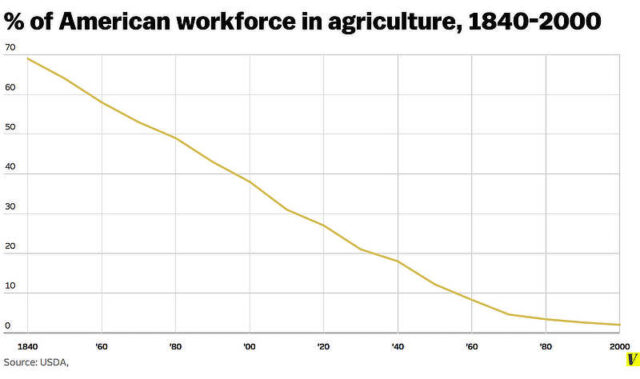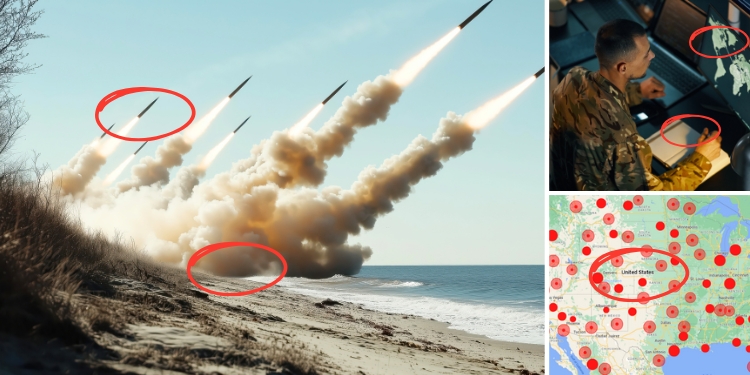Today in the United States, fewer than 1 percent claim farming as an occupation, and only 2 percent of Americans live on a farm. In my opinion, this translates to a systemic risk for the 98 percent of people who literally depend on them for their food.
It looks even worse from the following perspective.. Farmers and ranchers themselves make up just 1.3% of the employed US population, totaling around 2.6 million people. That’s just 0.8% of the U.S. population as of this post.
There are various ways to slice this pie. Total ‘agricultural’ related employment numbers don’t look quite as scary, but still… “Agriculture and its related industries provide 10.5 percent of U.S. employment” according to the USDA.
From the standpoint of what I consider to be systemic risk, I’m concerned about the extremely low number of American family farms compared to years past.
According to data from the USDA, 70% of the American work force worked in agriculture in the year 1840. Whereas in the year 2000, barely 2% worked strictly in agriculture.

Fewer Small Farms and Workforce
What has changed? Well, lots of things.
Technology has enabled scale of efficiencies in farming.
Big farms and corporate farming have swallowed up a tremendous number of small, medium, and family farms – for a number of reasons.
Burdening regulations that only ‘big money’ could deal with, which resulted in many farmers having to sell or face bankruptcy. (It’s not exactly a high margin industry).
Most remaining family farmers are what you might consider to be the older generation. There’s little interest among the young who may find better financial opportunities elsewhere. In America today, the average principal farm operator is 58 years old, nearing the age of retirement.
Food Supply in the Hands of the Few
Whatever the many additional reasons are, the fact is that much our food supply is in the hands of the few – most of whom are ‘big farming’ and/or part of ‘big corporate agriculture’. And they do not necessarily have your best interests in mind.
Don’t get me wrong.. they’re producing lots of ‘food’ (and exports). However the way I see it – this has put most of our eggs in one basket, so to speak.
From the standpoint of prepping & preparedness, I see all this as a fairly significant risk. The risks associated with big-farming / corporate profits versus things like nutrition, sustainability, ‘real food’ (just to name a few).. And think about the great distances involved from farm to table (and the things they have to do (e.g. modifying foods) to overcome this).
Putting the majority power and control of our food supply into ‘big money’, ‘big agriculture’ seems a bit risky to me. In America, the big get bigger and the small go out.
And what about the fact that we’re ‘hooked’ on this system? The family farms are almost essentially gone. As more small farmers give up or give in, there’s quite an impact on rural communities and supporting infrastructure. Much to the glee of big agriculture.
Side note: Did you know that Bill Gates is now apparently the biggest owner of farmland in the United States?
What You Can Do About It
Support local farming. Don’t gripe about the price at a Farmers Market – they have to eat too. Grow your own garden, however big or small. Help out a farmer if you are able. Support community farming / gardening.
Sometimes (within the prepping & preparedness arena) we might hypothesize what would happen under one of many ‘worst case disaster scenarios’. Well, the food department ought to be one of your major priorities. It’s one thing to have plenty stored away. But what about when it runs out and supply chains are essentially non-existent? It will take a functioning community focused on sustainability to overcome. The more small farms around – the better..


